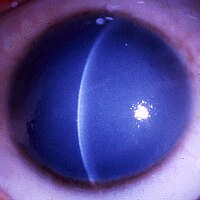Congenital hereditary endothelial dystrophy

Congenital hereditary corneal dystrophy (CHED) is a form of corneal dystrophy which presents at birth.
Genetics
CHED has two types:
- type I or the autosomal dominant form.
- type II or the autosomal recessive form is linked to mutations in SLC4A11 gene
Clinical presentation
In the recessive form corneal clouding is observed at birth or within the neonatal period, nystagmus is often present, but no photophobia or epiphora is seen. In the autosomal dominant type corneal opacification is usually seen in the first or second year of life and progresses slowly, and nystagmus is infrequently seen.
See also
References
- ^ Vithana EN; et al. (July 2006). "Mutations in sodium-borate cotransporter SLC4A11 cause recessive congenital hereditary endothelial dystrophy (CHED2)". Nat. Genet. 38 (7): 755–7. doi:10.1038/ng1824. PMID 16767101.
{{cite journal}}: Explicit use of et al. in:|author=(help) - ^ Online Mendelian Inheritance in Man (OMIM): 217700
- ^ Online Mendelian Inheritance in Man (OMIM): 121700
